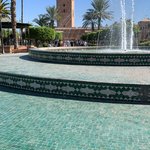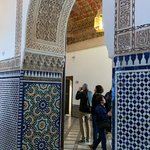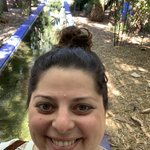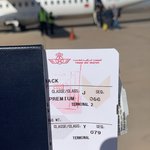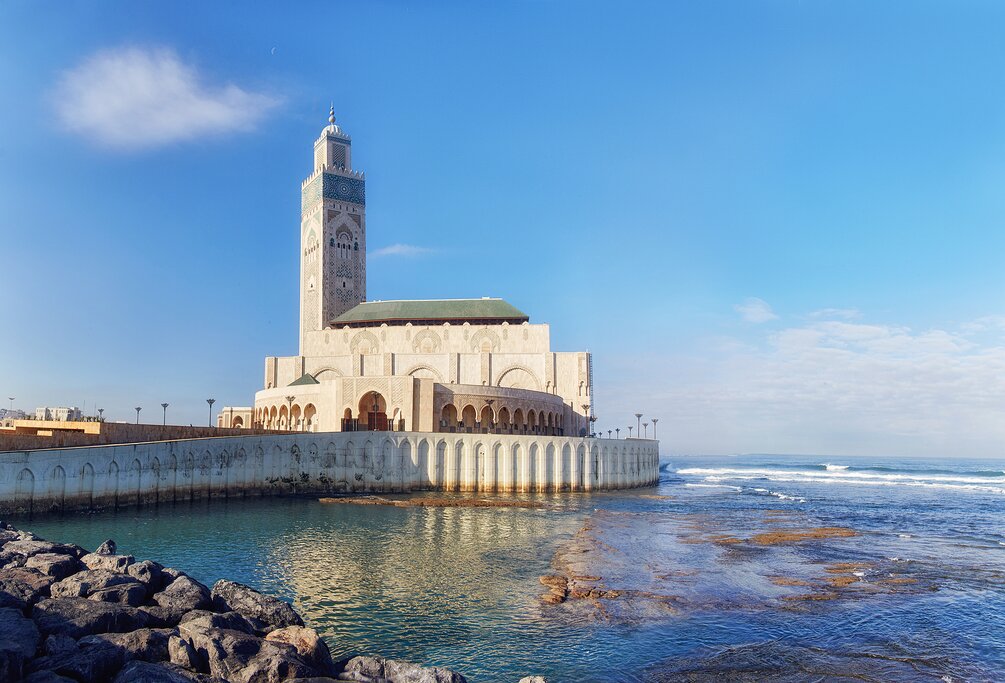
Moroccan Cities Grand Tour - 8 Days

Highlights
- Visit the Hassan II Mosque and the world's tallest minaret in Casablanca
- Enjoy a sunset over the "Blue City" of Chefchaouen in the Rif mountains
- Discover souks, tanneries, and artisan workshops in medieval Fes
- Watch musicians, acrobats, and snake charmers in Jemaa el-Fna Square
Brief Itinerary
| Day | Highlights | Overnight |
|---|---|---|
| Day 1 | Arrive in Casablanca, Transfer to Rabat | Rabat |
| Day 2 | Transfer to Chefchaouen, Explore the The Blue City | Chefchaouen |
| Day 3 | Transfer to Fes via Volubilis & Meknes | Fes |
| Days 4-5 | Explore the Medieval Medina of Fes | Fes |
| Day 6 | Transfer to Marrakesh | Marrakesh |
| Day 7 | Marrakesh: Exploring the Red City | Marrakesh |
| Day 8 | Return to Casablanca, Depart |
Detailed Itinerary
Day 1: Arrive in Casablanca, Transfer to Rabat

Welcome to Morocco! Welcome to the modern coastal city of Casablanca. Casablanca's main attraction is the relatively modern and monumental Hassan II Mosque. Inaugurated in 1993, it sits on an outcrop jutting into the Atlantic and offers beautiful views. It has a 690-foot (210 m) minaret—the tallest structure in Morocco and the tallest minaret in the world. What makes this mosque unique is that it's one of the few mosques in the country where non-Muslims are permitted to enter. Join a guided tour and appreciate the fine examples of Moroccan and Islamic partisanship.
Venture north to the imperial city and present-day capital of Rabat (Meknes, Fes, and Marrakesh make up the remaining imperial cities). Explore the medieval fortification of the Chellah Necropolis and wander the Roman and Islamic ruins. Enter through the grand door of the Kasbah des Oudaias into Rabat's original city center. From there, visit the 20th-century Andalusian Gardens and enjoy the serene space away from the crowds. Discover the Hassan Tower, a minaret of the incomplete mosque and Mausoleum of Mohamed V. A 12th-century project that was abandoned soon after construction began.
Day 2: Transfer to Chefchaouen, Explore the The Blue City

This morning, head north to the striking blue city of Chefchaouen in the Rif Mountains. Just before you reach the Blue City, stop to hike (two to three hours) through lush vegetation and small pools to enjoy the Cascades d'Akchour (Waterfalls of Akchour)—a hidden gem. Arrive in charming Chefchaouen. Mostly untouched since the 15th century, Chefchaouen offers a relaxed atmosphere with some of the friendliest people in the country and is known for its blue-washed buildings in its historic medina (old quarter). Explore its narrow streets and alleyways, which cling to the northern hillside of the mountains.
Discover Plaza Outa el-Hammam, the main square named for the number of hammams (public baths) that used to encircle it. Find a restaurant or café for a bite to eat before browsing the many shops offering traditional wares. Visit the Grand Mosque and kasbah (old fortress or fortification) and tour the kasbah's garden, museum, and even some of its old prison cells. As the evening approaches, ascend the path leading to the never-used, white Spanish Mosque (20 to 30 minutes) to enjoy one last view over Chefchaouen as the sun sets behind the mountains.
Day 3: Transfer to Fes via Volubilis & Meknes

Meet your driver and head northeast toward Fes. Along the way, stop and stretch your legs to explore Meknes. A smaller version of Fes, Meknes offers a calmer medina, and shopkeepers are not as pushy to make a sale. While Meknes is quite large, the two main areas of interest are the Ville Impériale (Imperial City) and the manageable medina. Be sure to check out the grand Bab al-Mansour gate and the Mausoleum of Moulay Ismail. Next, visit the Roman ruins of Volubilis. A UNESCO-protected site founded in the third century BCE, it remains incredibly well-preserved.
Carry on eastward to Fes. Before venturing into the medina, take the time to complete a short trek up a hill to the ruins of the Merenid Tombs for an all-encompassing view of the medieval city. The best time to visit the tombs is around dusk. The muezzin's calls to worship can be heard through the valley as the city lights begin to glow, adding to the atmosphere. Return to your traditional riad for a warm meal and settle in for the evening.
Chat with a local specialist who can help organize your trip.
Day 4: Explore the Medieval Medina of Fes

The oldest of the imperial cities in Morocco and perhaps the most interesting and exciting to explore, Fes has undergone little colonial development, adding to its medieval appeal. The most complete medina in the Arab world and a UNESCO World Heritage site, Fes is made up of three main points of interest: Fes el Bali (old Fes, the medina, and where you'll spend most of your time), Fes el Jdid ('new' Fes), and the French-influenced Ville Nouvelle. Meet your guide to learn more about the history and culture of Fes and, most importantly, to help you navigate the medina.
Begin your tour in Fes el Bali, starting at the Bab Boujeloud gate, welcoming you onto Talâa Kebira. Discover the wares for sale in the souks (markets) and shops as you pass the Spanish and Tunisian-influenced architecture. One of the most unique sights in the old Medina is the tanneries, and Chouara Tannery is no exception. Next, climb to the rooftop of a nearby leather shop for a better view of the 11th-century stone pots filled with dye and men working. Follow your guide to the University of Al-Qarawiyyin's library and Mosque (859 CE). If you're lucky, you may be able to sneak a peek inside.
Day 5: Free Day in Fes

Today, visit the Batha Museum. Housed in a 19th-century palace, the Museum is home to a collection of traditional Moroccan arts and crafts, including carved wood, zellij (mosaic tilework), and local pottery (its highlight). Spend time in the Andalusian-style gardens before walking to the Mellah (old Jewish quarter and cemetery). Take advantage of its location for a panoramic photo of the city. Continue south to Ville Nouvelle and discover the dramatic change in architecture.
Tour a ceramics and tile collective to learn how local artisans make wares, from shaping the clay to painting the designs. As well as watch the tile masters at work, fitting together small pieces of tile to form intricate mosaics. Return toward Fes el Bali, stopping along the way in Jnan Sbil (Bou Jeloud Gardens)—the halfway point between the Mellah and Bab Boujeloud. Spend some time relaxing in the gardens' grandeur and cool off in the central fountains or beside the lake.
Day 6: Transfer to Marrakesh

Today, you'll make the journey west to the coast and then south to Marrakesh. In order to break up the drive, you'll have the option to stop in Meknes, Rabat, or Casablanca.
You may want to spend the rest of the afternoon at a slower pace. In the early evening, Jemaa el-Fna comes alive with musicians, performers, snake charmers, and games. As the Square is best experienced in the evening, roam its stalls and vendors taking in the spectacle. Grab a bite at one of the many food stalls, or if you want to enjoy the goings-on from a distance, choose one of the cafés surrounding Jemaa el-Fna and enjoy a cup of mint tea and a meal. Take an evening stroll and walk the short distance to admire the floodlit Koutoubia Mosque before retiring to your accommodation.
Day 7: Marrakesh: Exploring the Red City

Nicknamed the "Red City" for its 1000-year-old red sandstone city walls and buildings, Marrakesh is a major economic center. Begin your day revisiting the 12th-century Koutoubia Mosque and take a respite from the heat in its gardens amid fountains and palms. Indulge your senses and explore the spice market, Souk el-Attarin, or Souk Smata, for your choice of slippers, rugs, and leather goods. Next, visit the Islamic school, Ben Youssef Madrasa, for a taste of 16th-century architecture and marvel at the details: arabesques, Islamic calligraphy, and colorful geometric tilework.
As you walk Marrakesh's alleys, notice the fondouks or caravanserai—medieval inns along ancient trade routes that provided travelers and traders with shelter and supplies. Depending on the timing and your energy level, you may wish to visit a few sites south of Jemaa el-Fna. Some options to consider are the 500-year-old Saadian Tombs, the extensive courtyard and sunken gardens of the 17th-century El Badi Palace, or the intricate woodwork and painted ceilings of the 19th-century Bahia Palace. Return to Jemma el-Fna for a bite to eat before retiring to your accommodation for the evening.
Day 8: Return to Casablanca, Depart

Depending on your departure details, you may wish to stroll along the Boulevard de la Corniche to Rick's Café, a bar, restaurant, and café influenced by the movie classic, "Casablanca," and grab a bite to eat.
More Great Morocco Itineraries
Looking for more inspiration for your trip to Morocco? Check out these other Morocco itineraries, explore different ways to spend eight days in Morocco, or discover the best time to visit Morocco.

